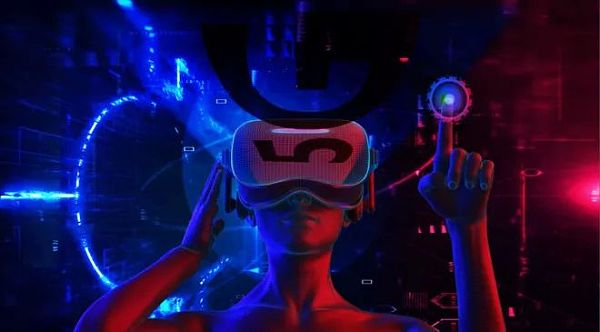The metaverse wave Businesses are improving the customer experience with AR and VR technologies
In a world where virtual reality interacts with each other, people enter a computer-simulated virtual space parallel to the real world through wearable devices such as headsets and goggles. …… This is the scene depicted by the American science fiction author Neal Stephenson in his 1992 novel Snow Crash, and is the origin of the term “Metaverse”.

Immersive technology has been associated with gaming at a time when part of the population’s awareness of it was still limited to science fiction.
Today, many businesses are recognising the significant advantages of using AR (augmented reality) and VR (virtual reality) to improve their operations, with AR and VR now being used in everything from product design and marketing to customer service, staff training and increased productivity.
As brands and businesses seek to develop the relationships between their services or products and their customers, technologies such as AR and VR offer practical, emotional and creative ways to enrich these relationships, while also increasing customer loyalty to the brand and increasing sales.
Immersive technology has huge potential to provide practical support for this, and its human-centred approach to design will deliver an emotional impact.
Technology has now become sufficiently advanced for the emergence of metaverse to push AR and VR into the mainstream so that they can be used to create a more friendly, realistic, approachable and affordable customer experience.
Key differences between VR and AR
In order to make the most of VR and AR, business owners must understand the differences between the two and the capabilities of each.
The main difference between VR and AR is that VR is designed to take users away from their physical space, in contrast, AR combines physical space with virtual space by overlaying parts of the real world with imaginary digital content.
Thus, while VR removes the user from reality altogether, AR blurs the line between the real and virtual worlds.
VR - Virtual Reality
The content of virtual reality varies widely, ranging from computer-generated interactive content to passive experiences like 360-degree images of the real world.
Users need to use specific devices, such as headsets and manual controllers, in order to access the most realistic VR content. These devices allow the user to see, hear and sometimes even have an interactive experience.
While they provide the most realistic VR experience, there are many VR experiences that do not require the use of additional aids, such as virtual shops.
VR is a great tool for businesses to build deep, lasting connections with their customers and prospects, and the immersive nature of VR is key to capturing users’ attention and evoking their empathy.
AR - Augmented Reality
Snapchat and the game Pokémon GO are the first and most famous AR applications.
AR is often easier to access than VR as it can be viewed and used on a smartphone or tablet without the need for a specific device.
While it doesn’t have the emotional impact that comes with a VR experience, its accessibility makes it a great tool to appeal to the mass market. Businesses can use AR technology to allow users to easily access and share content on the go or at home through any medium.
AR and VR in virtual worlds
Because today’s internet is not yet truly interconnected across software, many software applications are like islands.
Imagine a future world in which users can come and go between islands of news software, social media, online collaboration tools, banks and more.
In this scenario, the goal of the metaverse becomes clear: to create realistic environments that give users a 3D experience, such as interactive shopping trips, which will increase user engagement and merchandising rates, while keeping customers closely connected to the brand.
Today, most people still experience the internet through their mobile phones and computers, rather than using their digital bodies to hang out with friends in virtual worlds, attend virtual events and explore things like virtual shopping experiences.
Because people are still experiencing the internet off-screen rather than in-person, they are connected to the metaverse but still not well immersed in it.
But don’t worry too much, there are now more and more ways to experience the metaverse.
Retail is tapping into the metaverse
Today, AR, VR and the metaverse are being used to transform the processes by which brands sell merchandise and market themselves in ways that have never been seen before.
Retail and e-commerce are playing an important role in expanding the metaverse.
With AR and VR, merchants can immerse their customers in a virtual online shop of their flagship shop. They can also enhance their e-commerce offerings by turning their flat online shop into an immersive shopping environment.
Retailers, manufacturers and wholesalers can provide a superior, holistic experience that delights customers in an environment that eases decision-making and creates a memorable brand connection.
In home shops, for example, customers can view and interact with content such as dynamic countertops, floor assortments, wall types, movable furniture and home accessories from any screen at any time.
With these tools and technologies, clothing companies can also become part of an unfolding metaverse that remains open to all users in a virtual world, a metaverse, even when the doors of the physical retail world are closed.
If the metaverse becomes a reality, those companies that are already planning to offer a metaverse customer experience will have the upper hand.
Eighty-two per cent of companies experimenting with AR and VR say they are meeting or exceeding their revenue targets. Clearly, companies will become more open to the metaverse.
How VR and AR can enhance the customer experience
Consumers are increasingly relying on digital tools to make purchase decisions, complete the buying process and support merchants after the purchase. VR and AR provide the innovative tools companies need to support and improve their customer experience strategies.
Here are some of the most important reasons why businesses are using AR and VR today.
Informed decision-making
Interactive, immersive content experiences are helpful for customers who want to try something out before they buy, and most of today’s customers choose to learn the details of an item in advance before they buy.
From cosmetics to automobiles, companies across a wide range of industries are using AR technology to provide customers with the opportunity to make informed purchases.
Most consumers consider a combination of both emotional and rational aspects when deciding whether to purchase a product or service.
AR’s visualisation capabilities can help shoppers to remove any doubts about a service or product. They will feel more confident about their purchase and will be less likely to regret their initial purchase decision later.
Enhanced customer service
AR and VR technologies can improve the customer experience quickly and effectively by providing practical support throughout the buying process, from making it easier for customers to access product descriptions, to making it easier for them to connect with the product or service.
Immersive experiences
AR and VR combine to provide customers with a fully immersive experience, allowing them to imagine what they would look like with the item on at the time of purchase.
With 360 degree views and customisable options, customers can have an experience that cannot be achieved in the real world. When customers can personalise their products, they are often more likely to buy them.
Building user connections
AR and VR technologies allow businesses to delight customers and strengthen their bond with their brand by creating a range of immersive content in their customer experience centres. These connections help enhance the customer experience and help build brand loyalty.
Greater convenience
Wandering around a shop looking for a specific product is something that many shoppers find inconvenient. One of the great benefits of AR technology is that it can help customers browse the largest shops in seconds, easily find the products they are looking for and then have them delivered right to their doorstep.
Summary
A great customer experience is key to the survival of today’s businesses, and the impact on human interaction and relationships is looking increasingly ephemeral. technologies such as AR and VR are fast becoming the answer for businesses to build strong connections with their customers.
At the dawn of a new Internet age - a meta-universe full of opportunities for growth - these technologies have the ability to make users feel the value and uniqueness of a brand, which is what most customer experience strategies need and the foundation to help build growth in a business.




